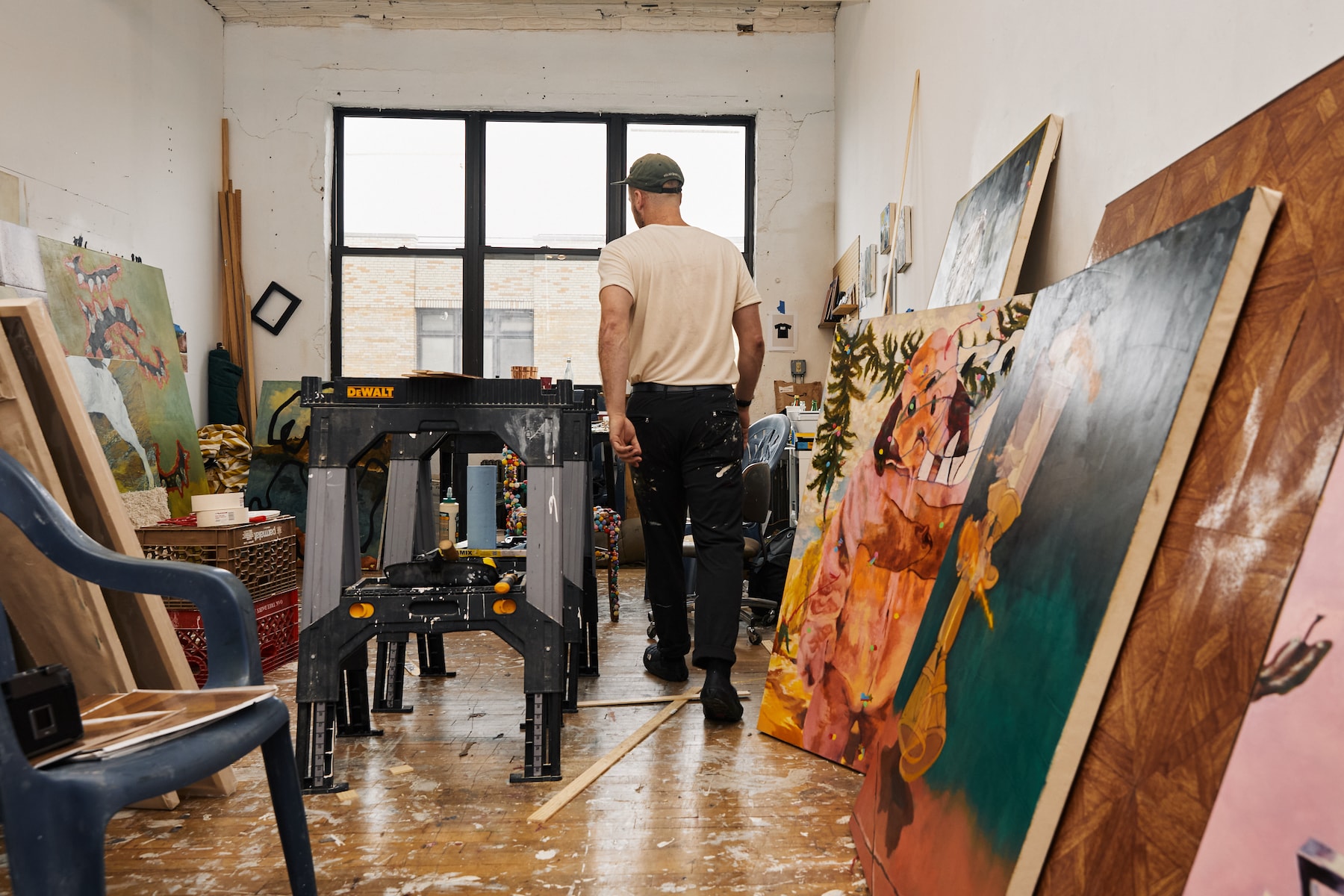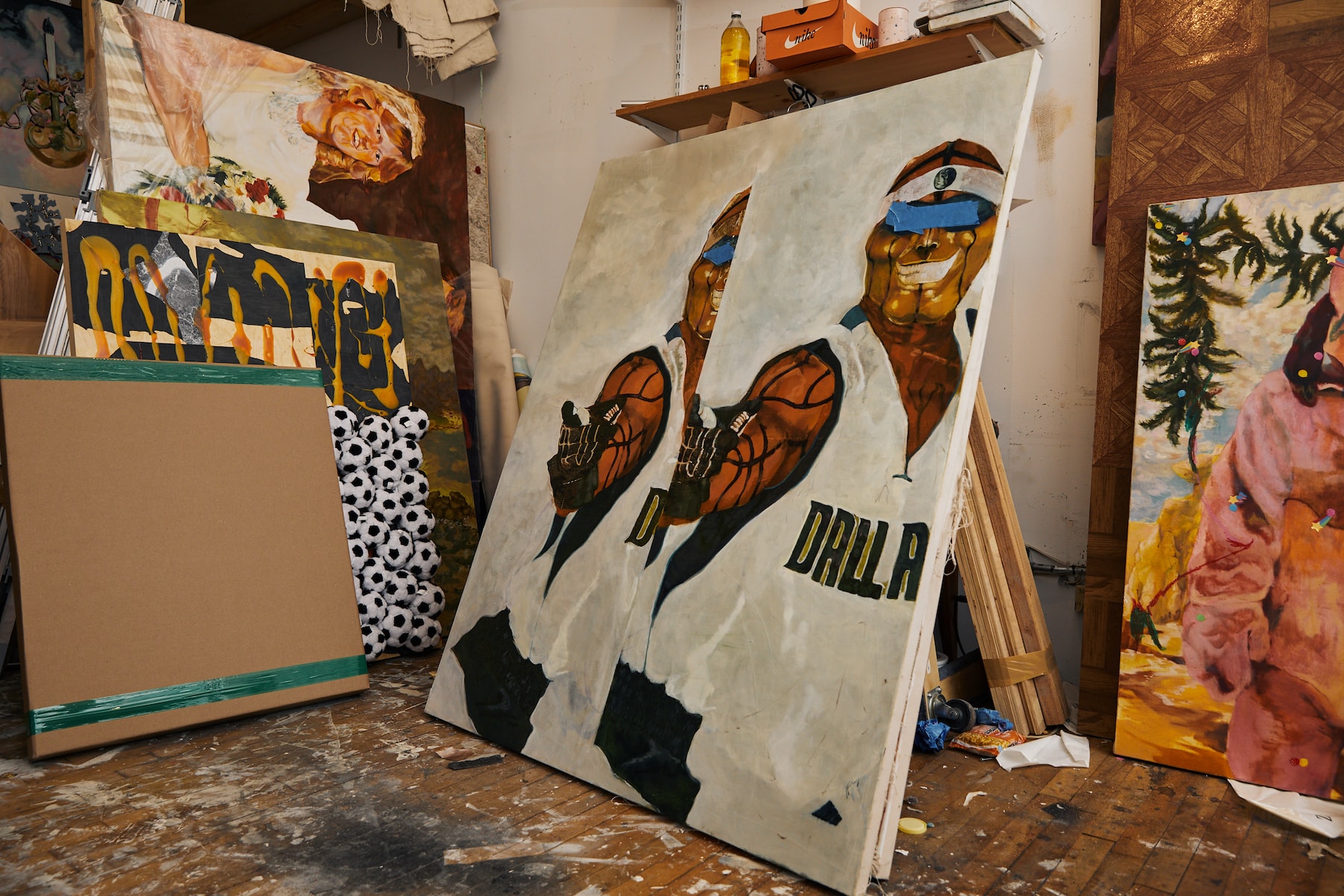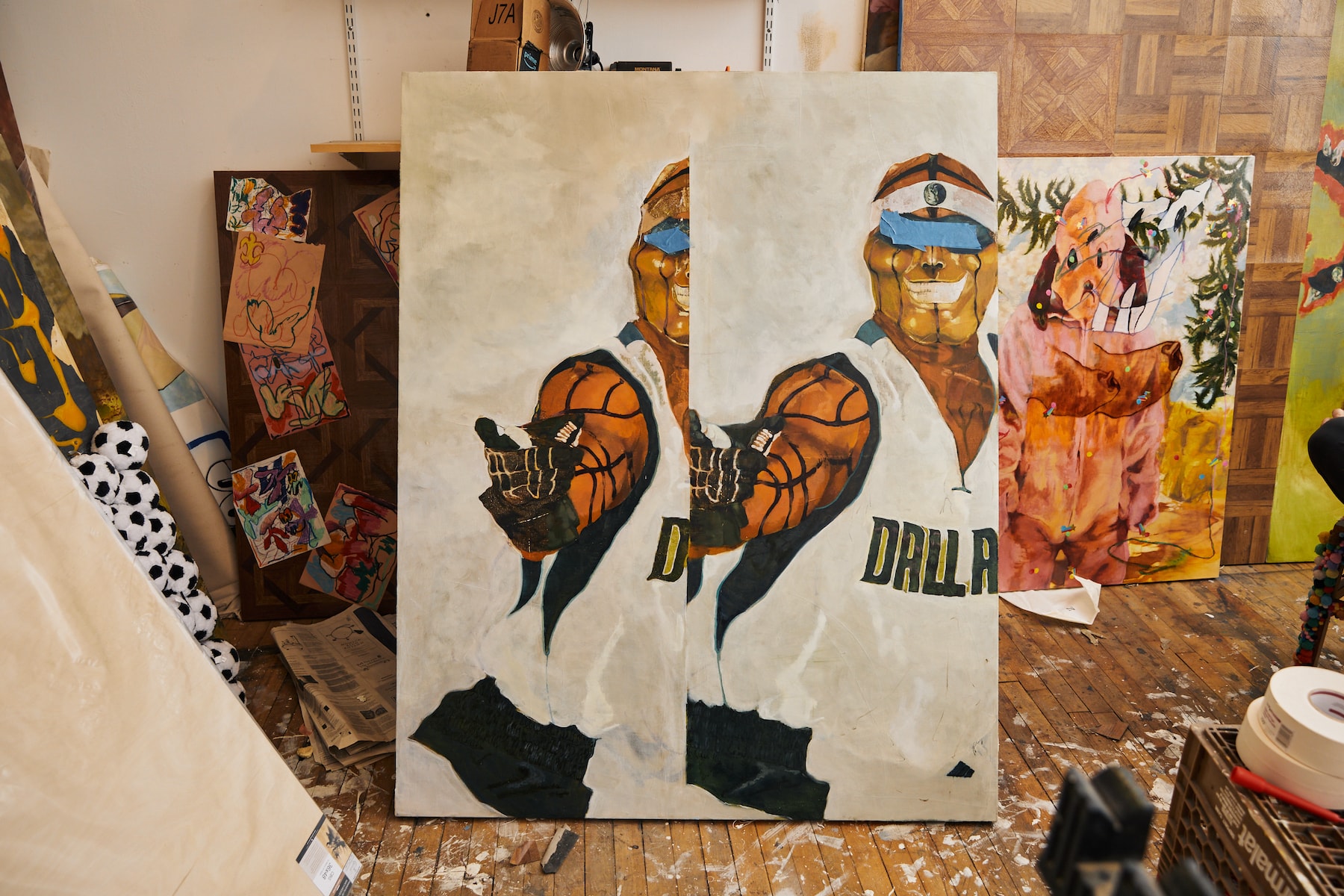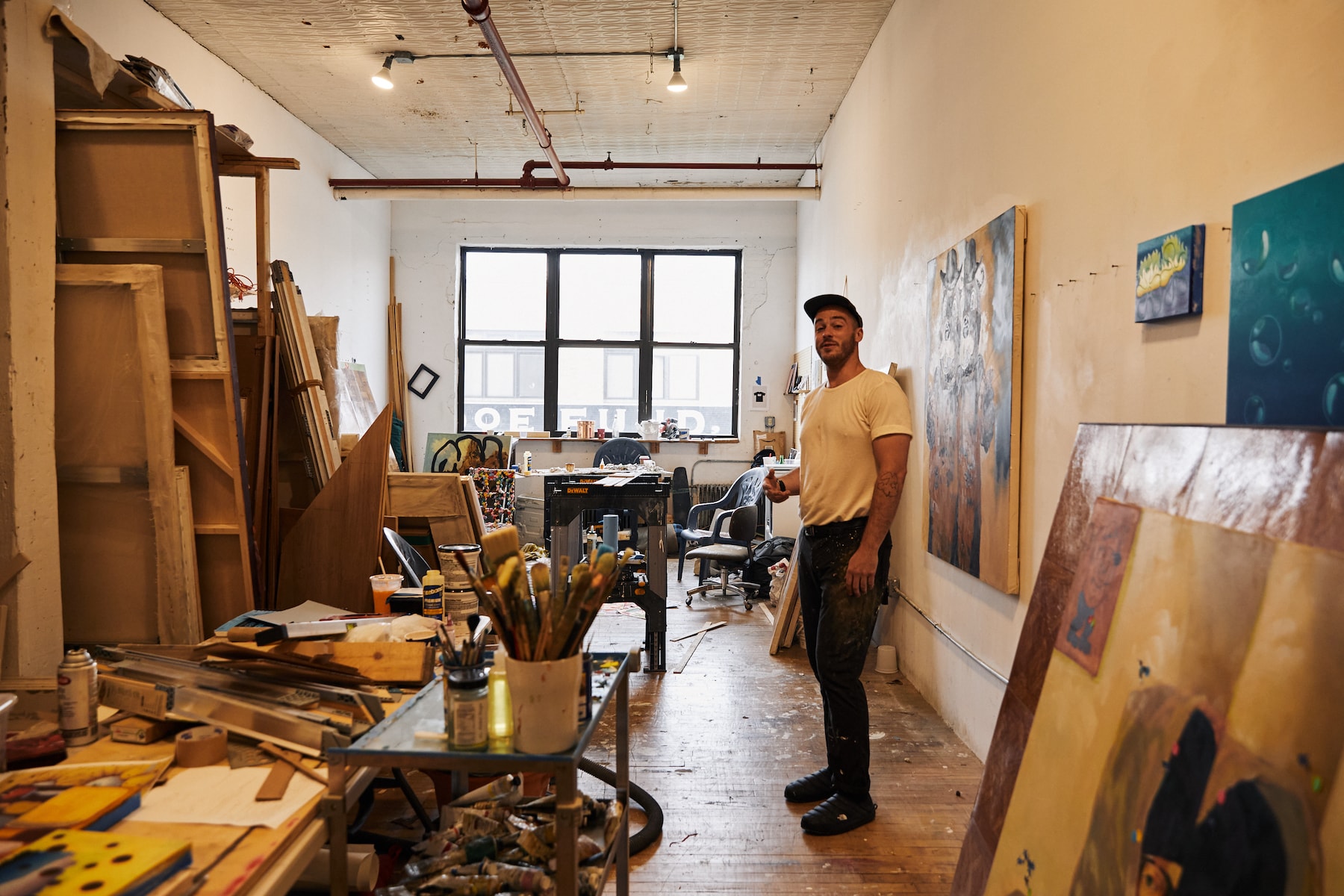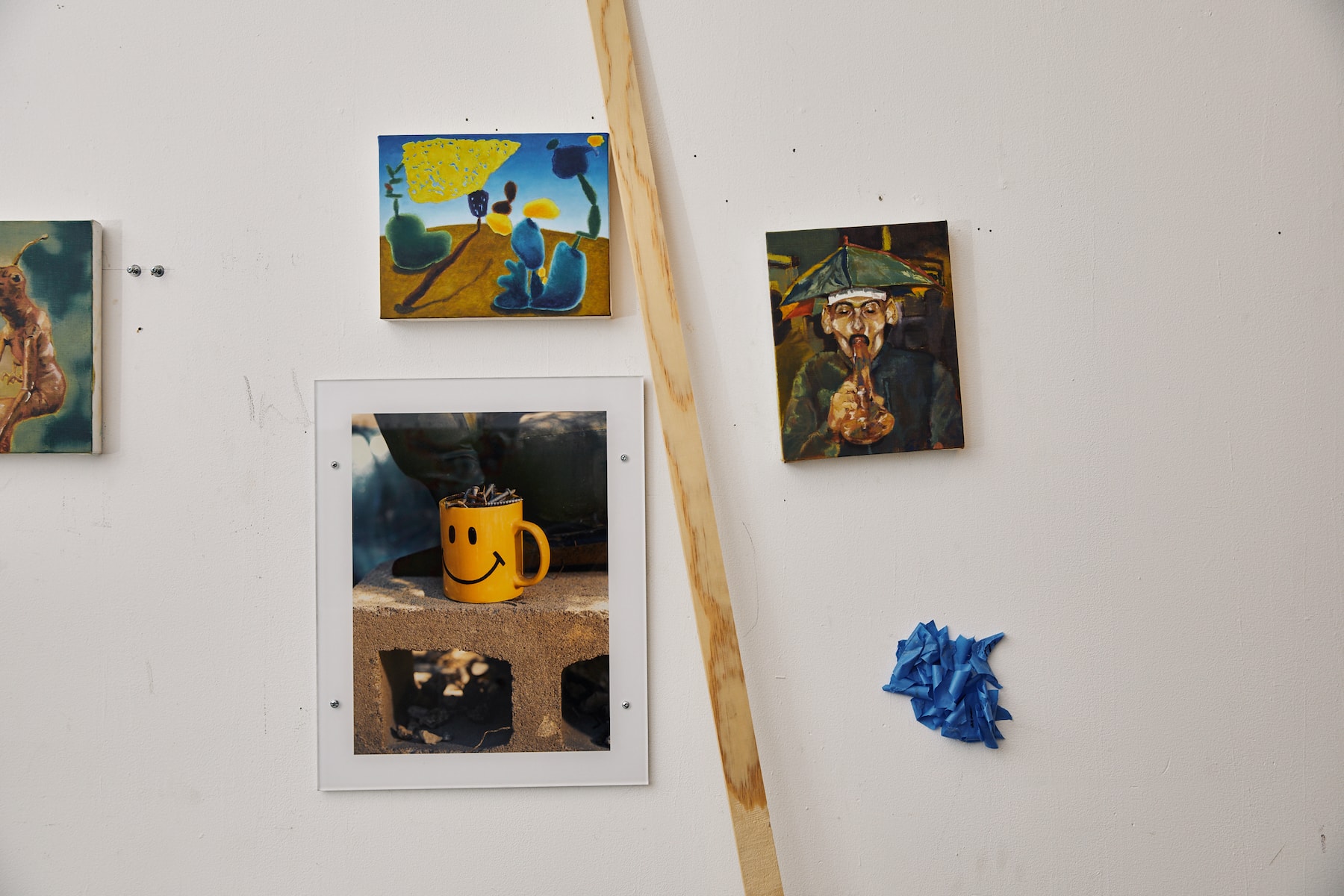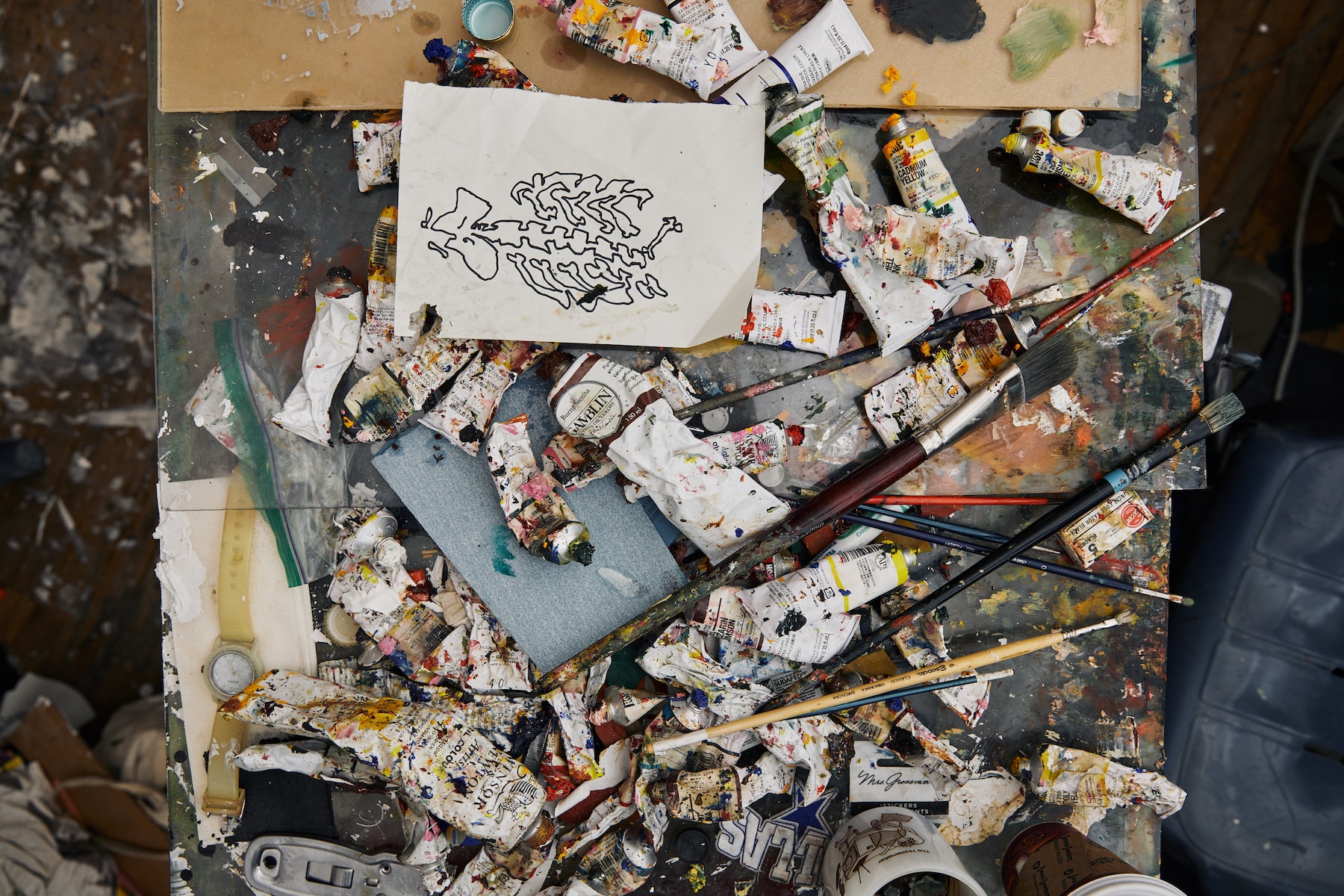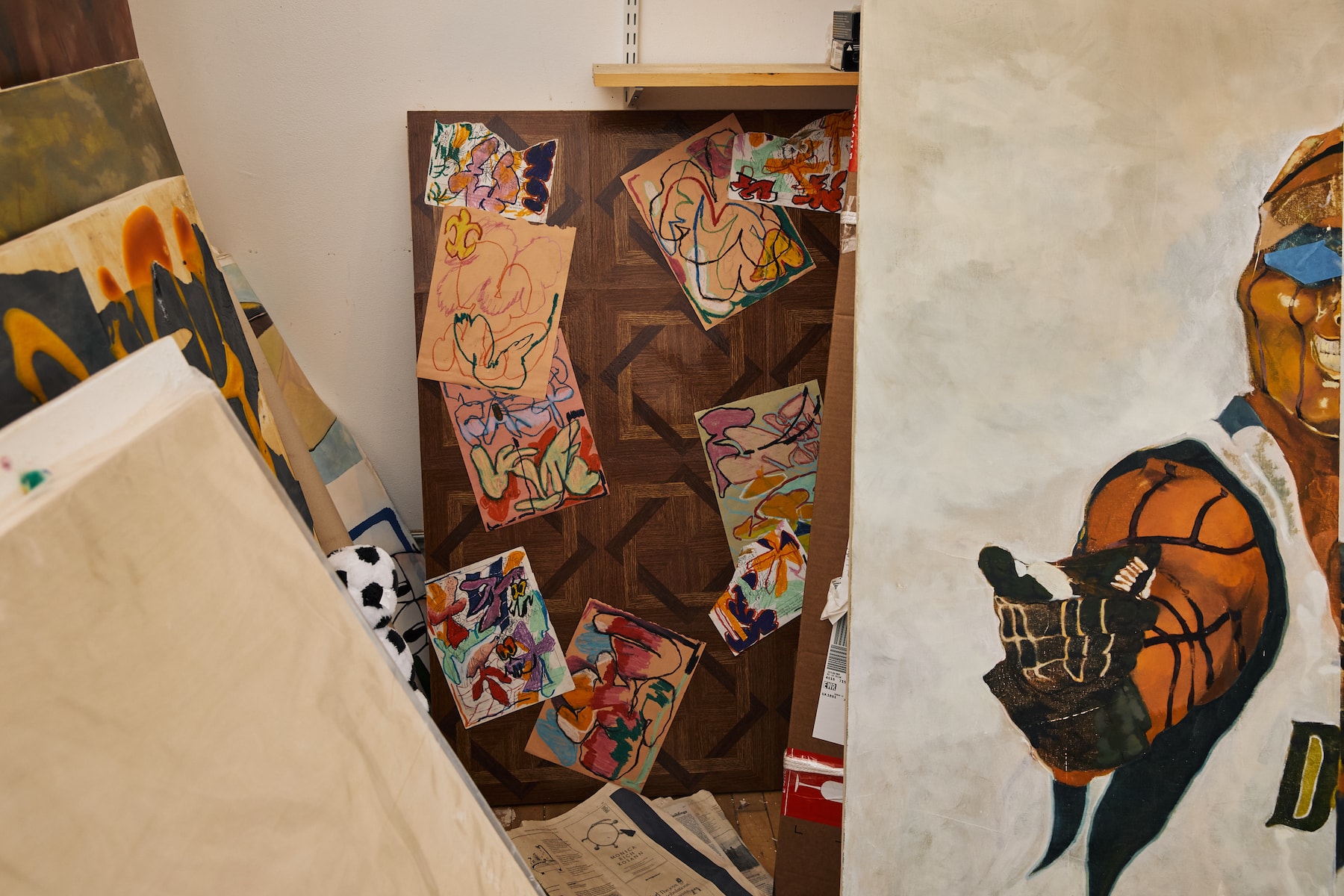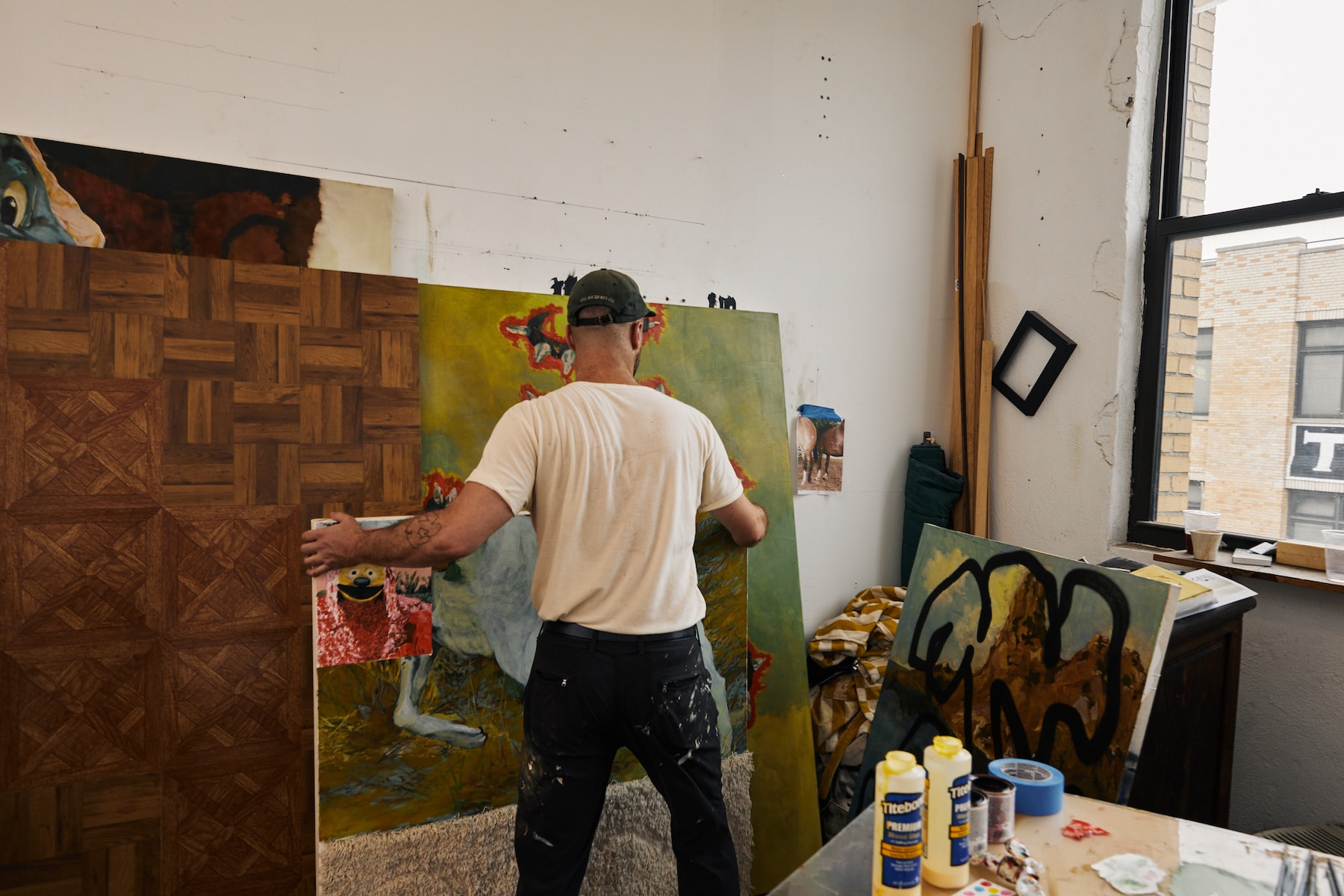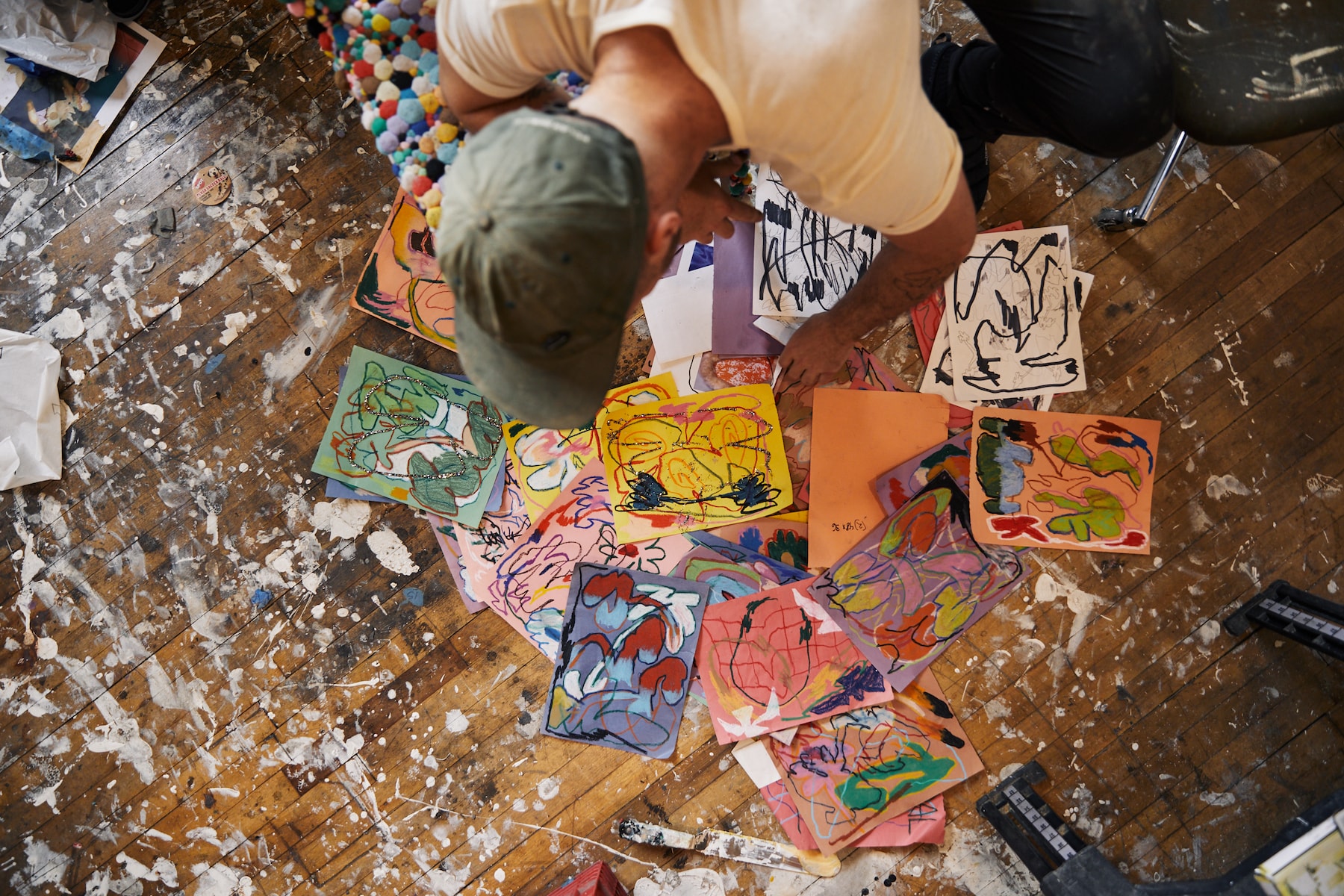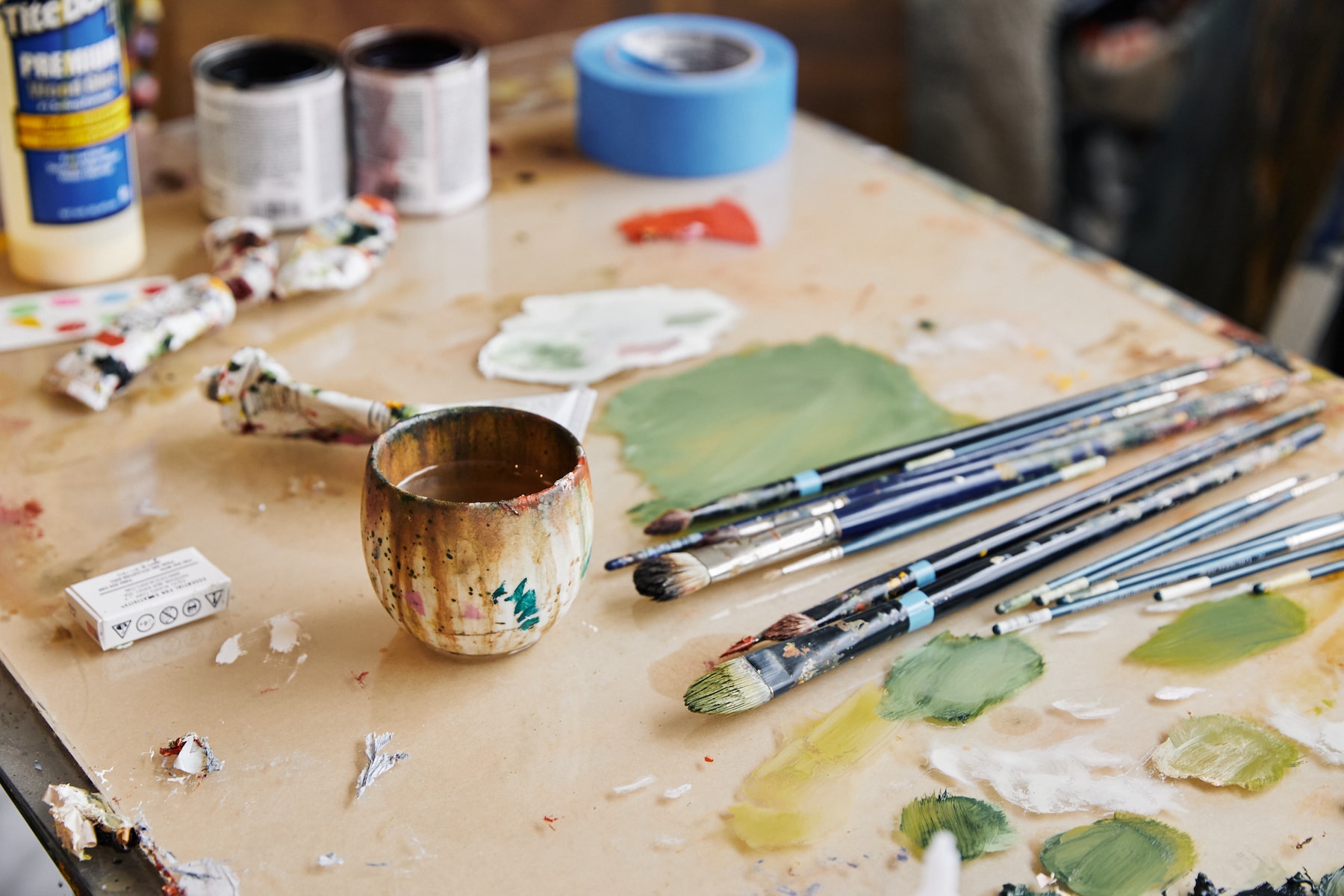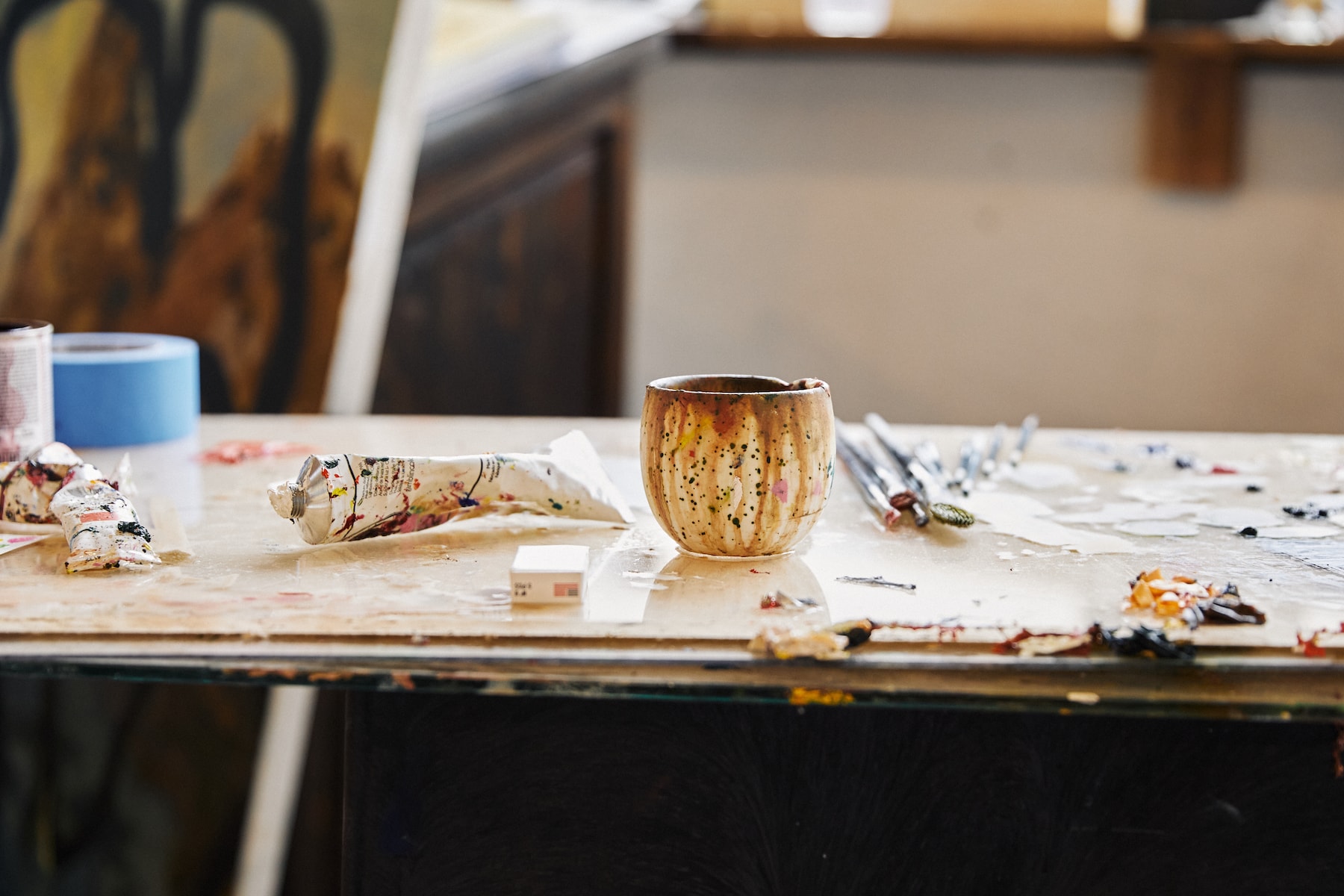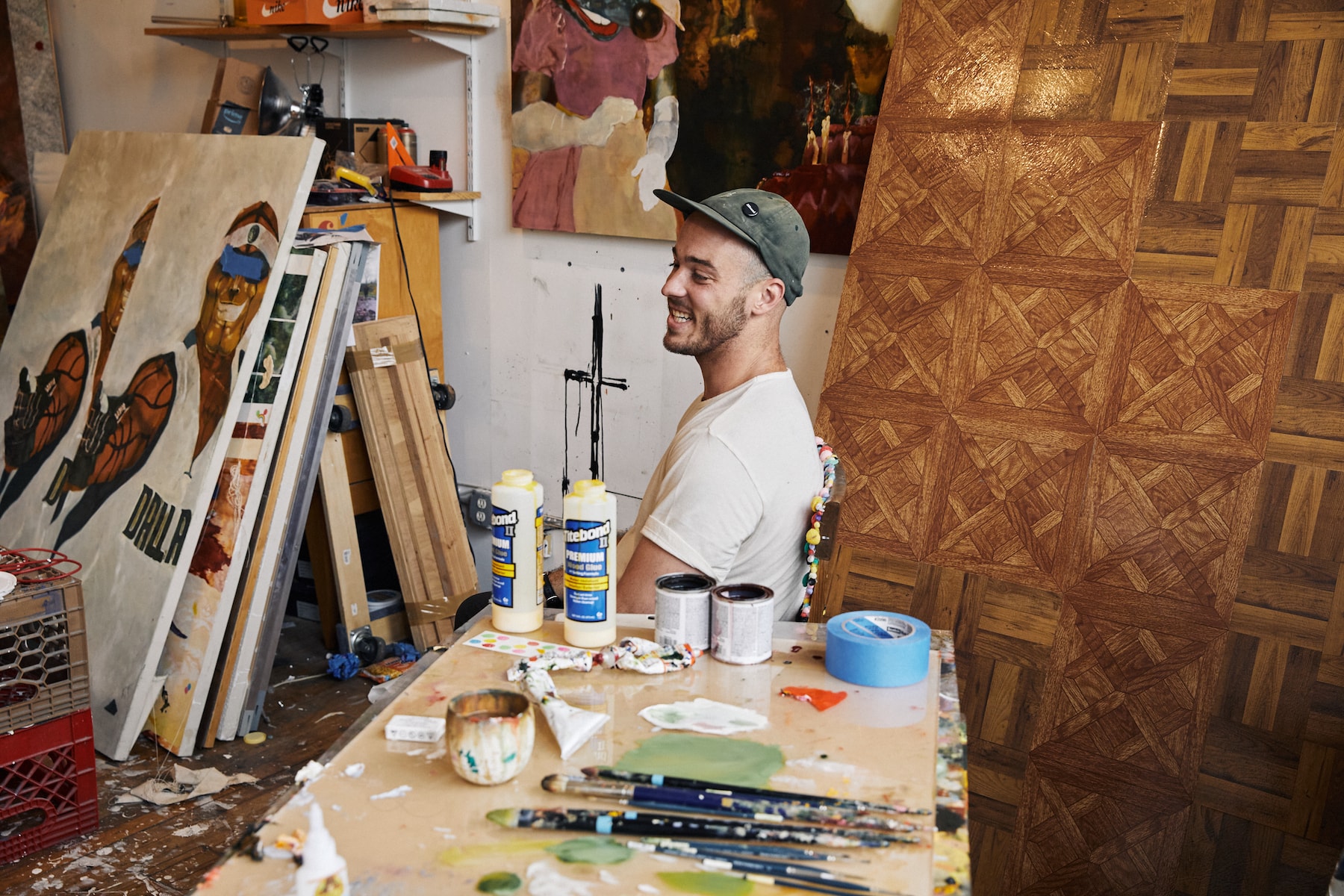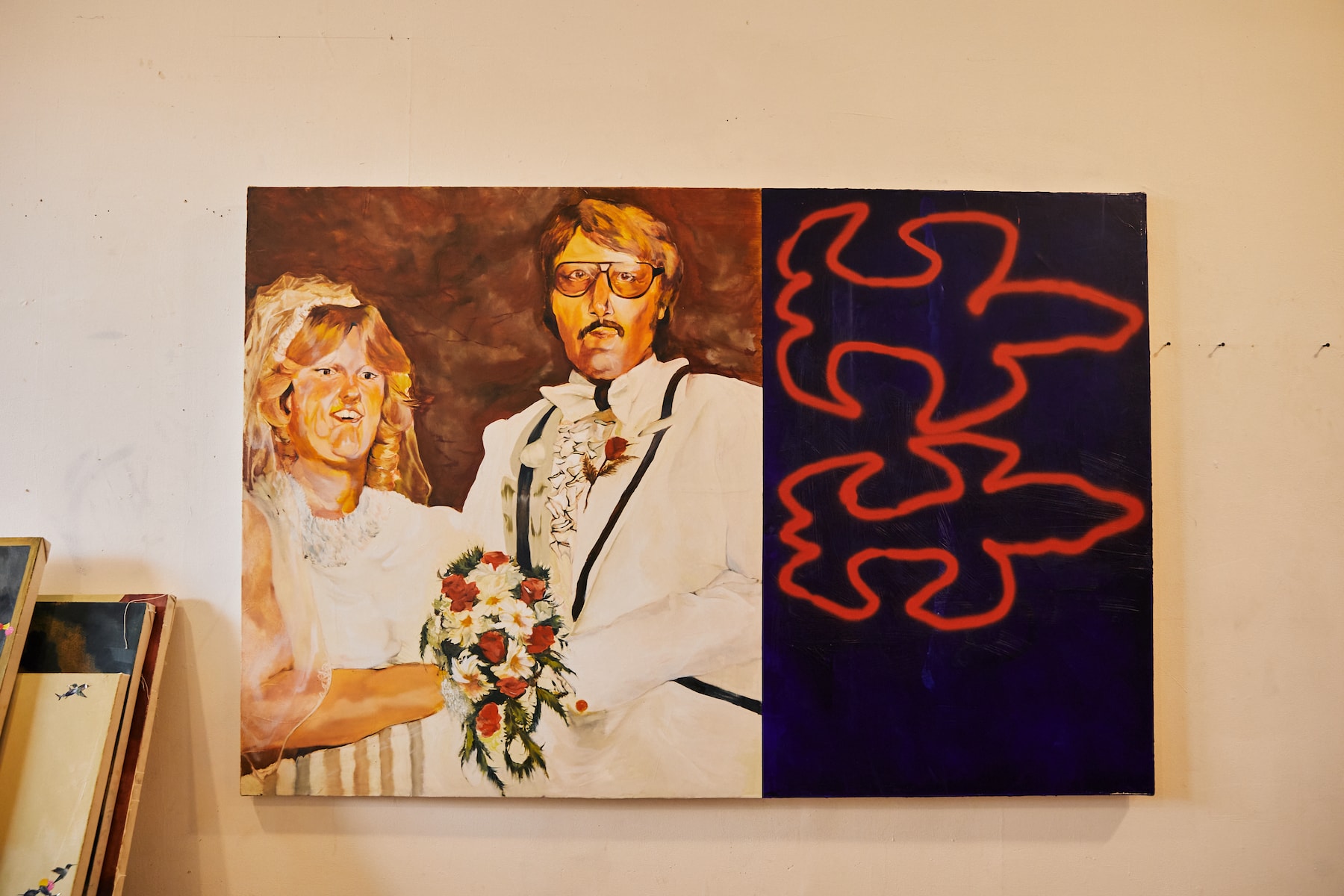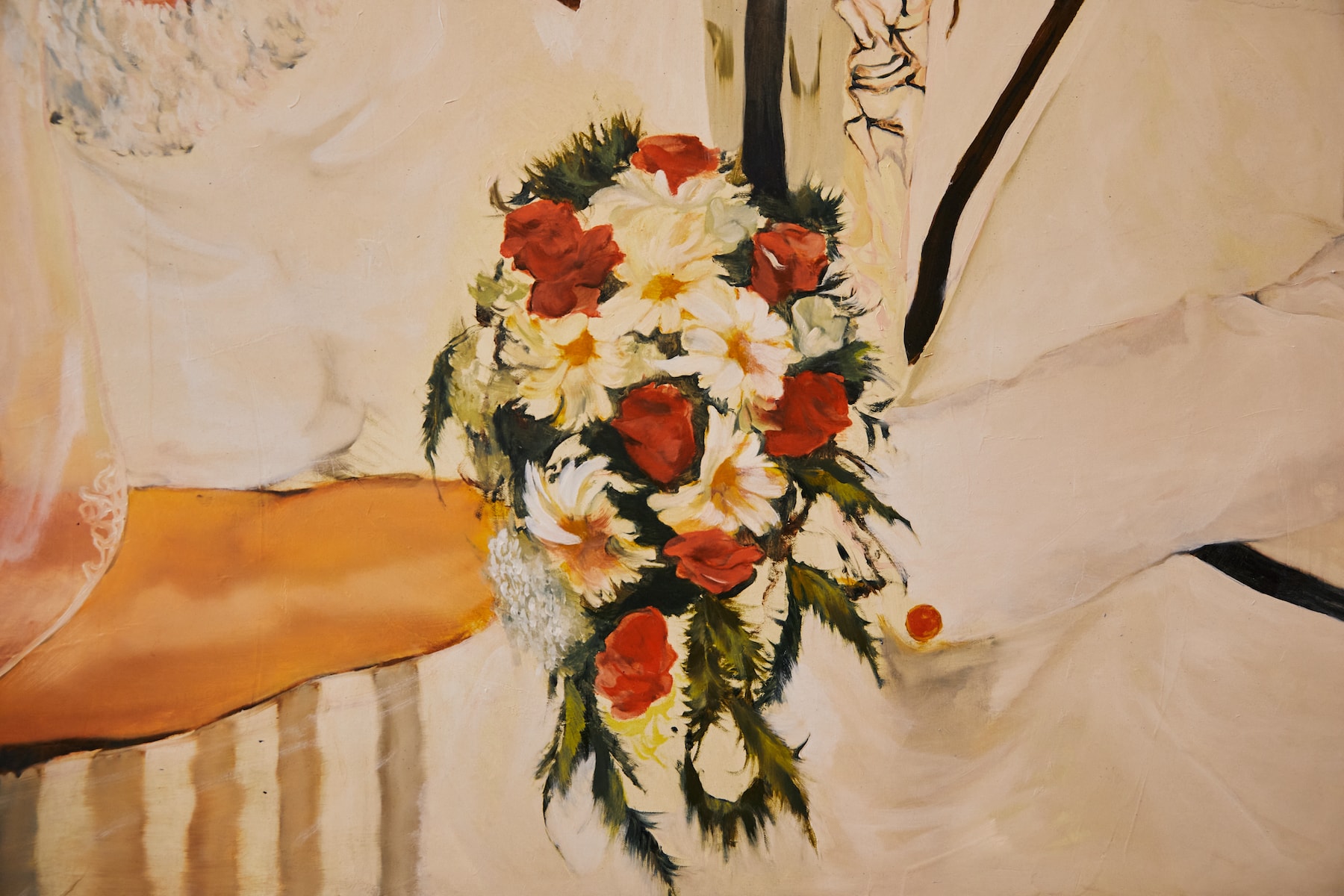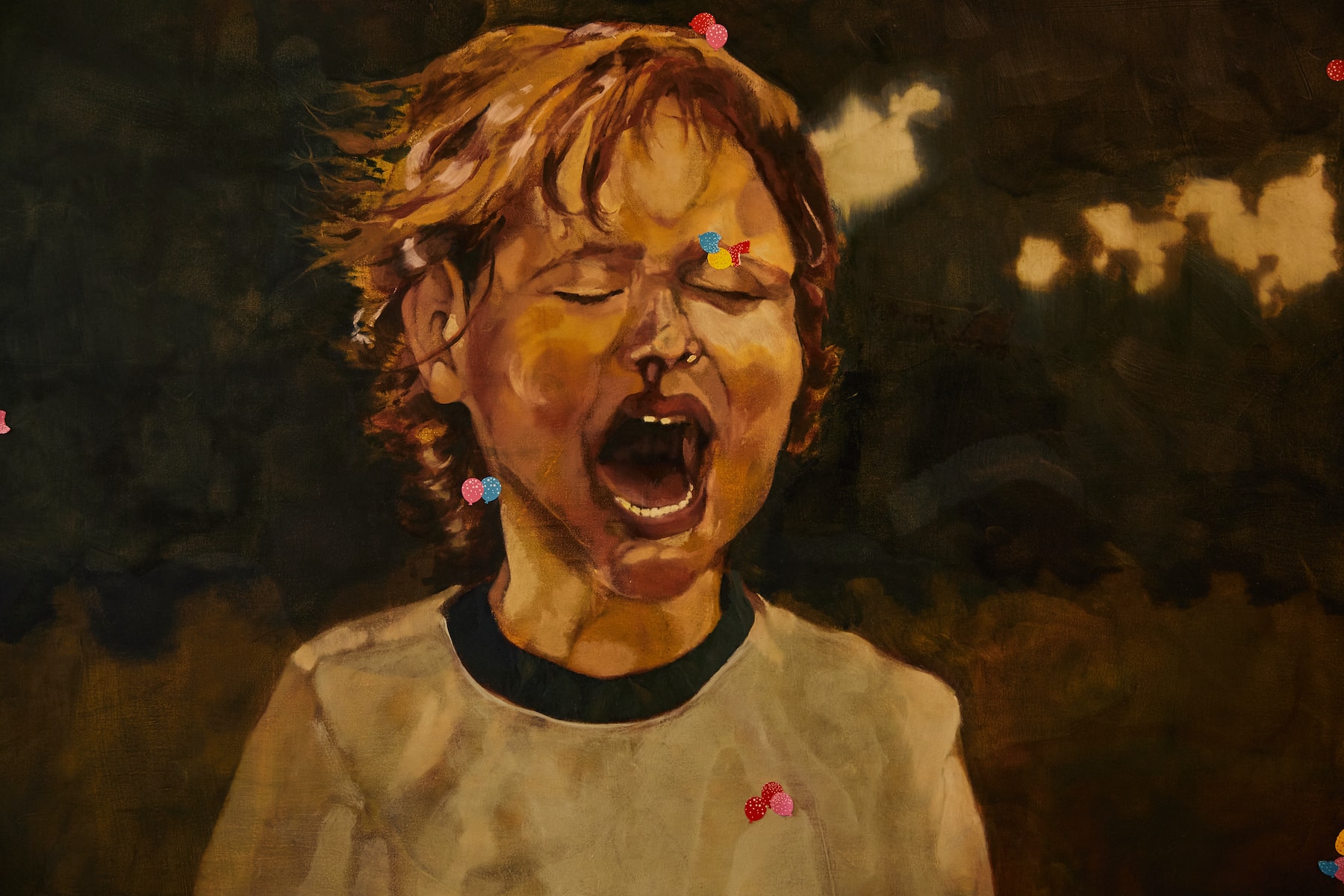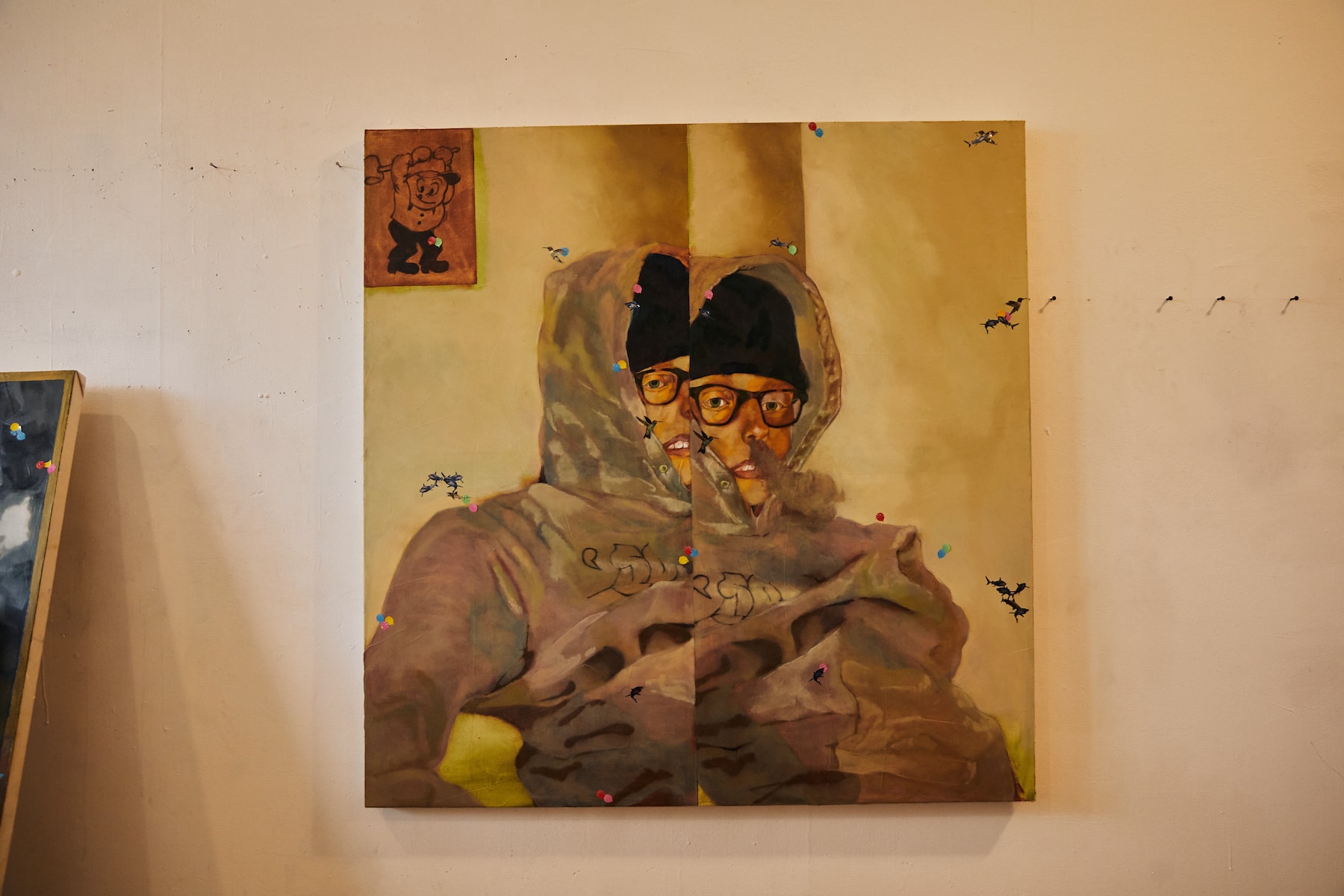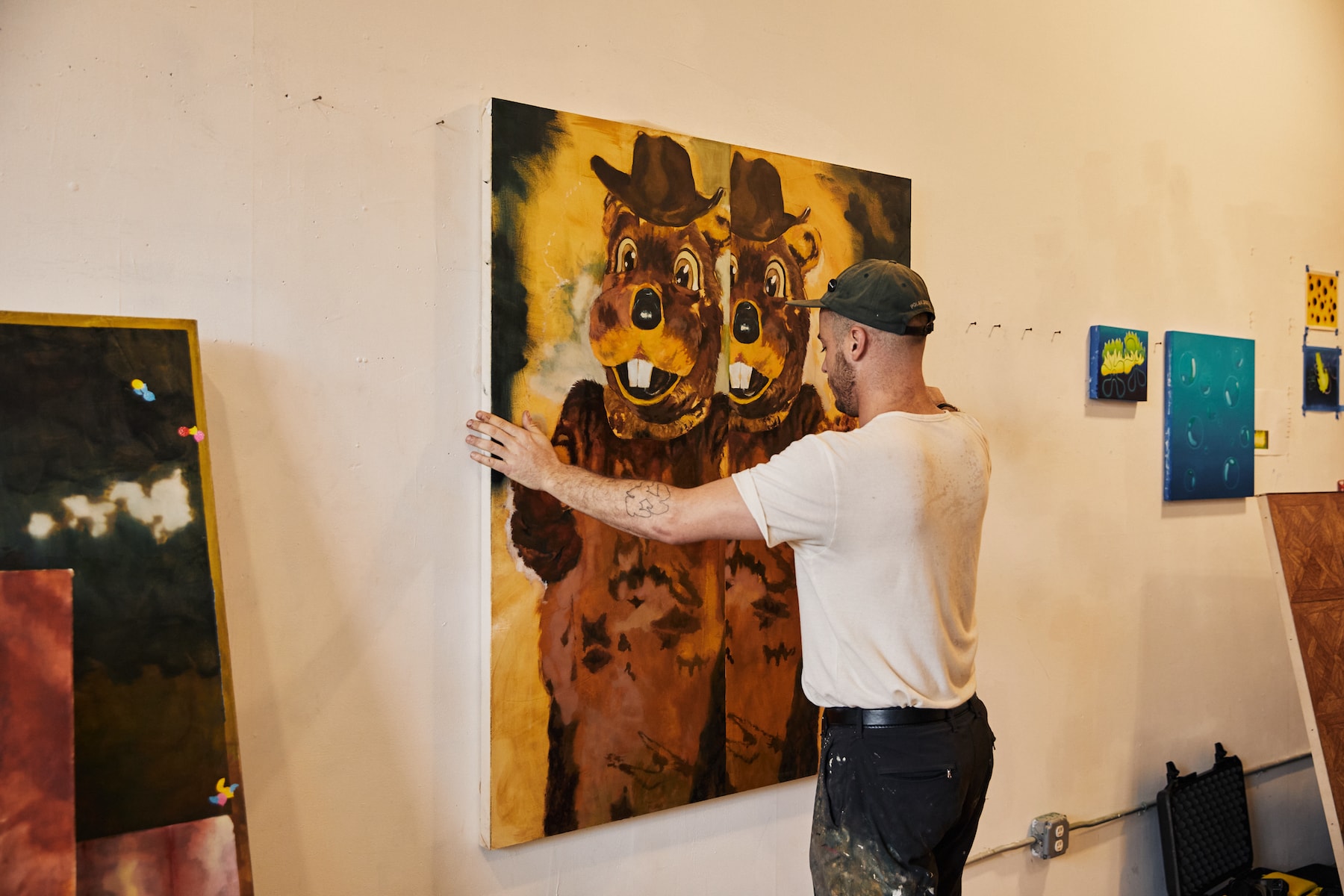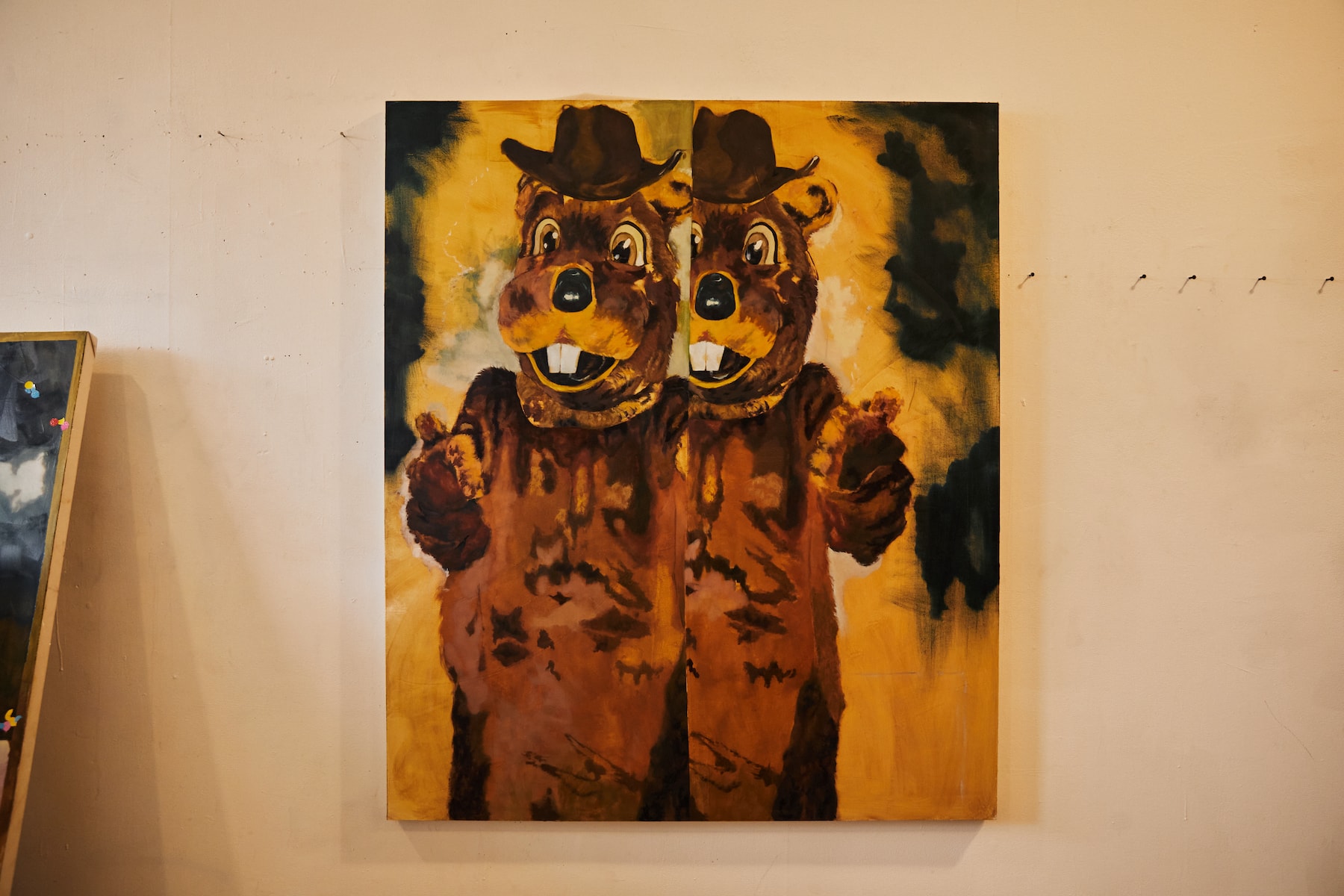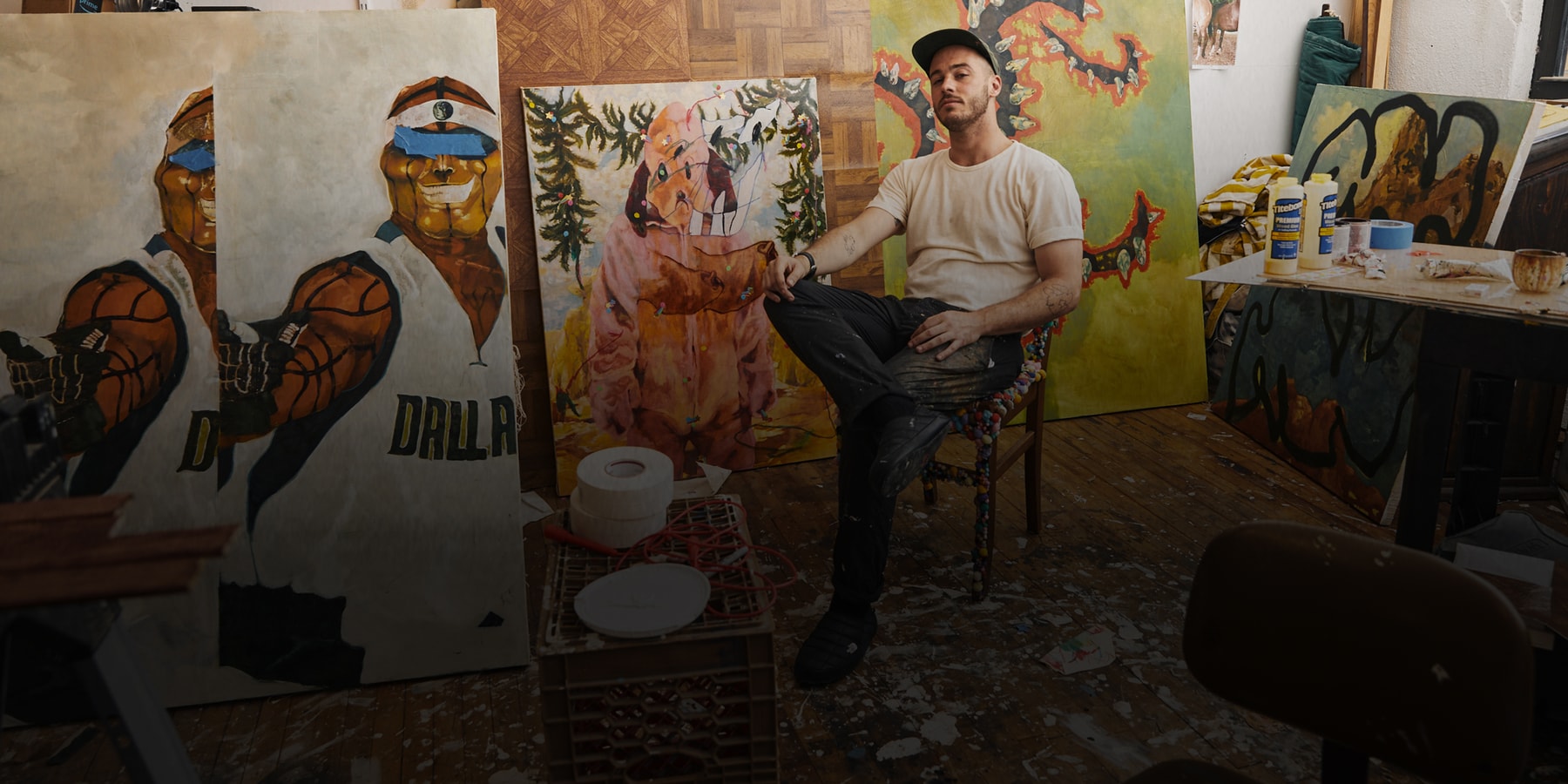

Henry Swanson’s oeuvre tugs at feelings of nostalgia as he toys with visual abstractions in his paintings and mixed media works that references his upbringing in Dallas, Texas, his obsession with comics and everyday moments. Though he was raised in a Texan region where arts wasn’t really encouraged, Henry’s fondness for drawing cartoon characters such as Calvin and Hobbes as well as Shonen Jump in his younger years catapulted his interest to learn more about visual art and its proper techniques. His passion led him to earn a BFA from the prestigious Rhode Island School of Design in 2016, and since then, he’s worked on sharpening his skills as a contemporary artist while navigating exhibition shows in the U.S. and internationally.
It’s not hard for onlookers to stare at Henry’s work for some time as his compositions merit investigations to probe the meaning behind a distorted double image of a Dallas Mavericks fan or a victorian light fixture painted above paper scrawling of obscure subjects. These are the subjects and elements in his work found in his most recent solo exhibition at Easy Otabor’s Anthony Gallery in Chicago.
Entitled Thorns in the Manger, Henry explored themes such as “luxury” and “familial happiness” to further examine what it means to be part of an American family unit or to spark dialogue for those who exist outside of that dynamic. Or as Anthony Gallery beautifully stated: “Thorns in the Manger navigates what it means to pursue the image of luxury and familial happiness. Swanson utilizes classical painting techniques paired with mixed media textures reminiscent of the American home. His work seeks not only to depict a sense of restrictive high-culture, but stage the scene of the dinner tables and childhood bedrooms where familial chaos and disaster happen.”
Material intricacy is also an element that Henry is also fixated with in his practice. He manifests details of a composition not only through painting, but by a slew of techniques utilizing varying mediums and a jolt of self-confidence. “For starters I’m a terrible shop worker. I’ve got no clue how to measure or cut anything appropriately and I treat my tools horribly. I hardly know how to load ink into a printer. But I usually try to keep my mixed media expenses to a minimum in that sense. If you’re going to fuck up a bulk amount of supplies by all means, but do it with your chest,” he said.
For our latest Studio Visits feature, we connected with Henry in his Brooklyn, NY studio to get a closer look at the internal workings of his practice as well as his future plans.
“Anyone from anywhere could be the next creator of something truly shaking, regardless of the background.”
As an artist, what are you trying to achieve in your work and career?
In my work, I’m looking to achieve something shared rather than something overtly critical; a sense of unity with my viewers through my own experience. Which definitely began with a deflective comedic bent to it, but that’s grown to be something more vulnerable – something I think art lacks a lot right now. Vulnerability.
Where did your art journey begin? Describe the moment you wanted to pursue an artist career.
Really no particular order of things. I grew up reading Calvin and Hobbes and drawing cartoons from out of the funny pages – even the ones that weren’t funny (Doonesbury, Judge Parker). Then kind of graduated in third grade to proper comics like Shonen Jump or whatever was on Toonami. I was also reading a lot of MAD Magazine. So proper museum arts and painting never occurred to me until I was practically in college and that was when I really committed. My family friend was a high school professor and encouraged me to actually apply. Coming from a background in a city that didn’t encourage the arts I always thought art was a take on all comers path, which still is a mantra I stick with. Anyone from anywhere could be the next creator of something truly shaking, regardless of the background.
You expressed: “Art exists to me as a visual and tactile experience in which I play more the role of a craftsman than I do a director of culture.” What made you want to harness this approach to art-making?
There’s a need to understand all of your options before you begin to start being a corny jackass. And I still feel like I’m learning everyday the more options I have as a craftsman, so naturally I’m still looking forward to my corny jackass phase.
“I’m very against projectors and Photoshop as studio tools.”
What does a day in a studio look like? Tell us about the atmosphere you work in when creating work.
Everyday I walk in around 10 am. I call my friend Anthony around 11 to hassle him about coming into the studio. He’s usually in the bathroom about to head over. I throw on music that isn’t something good but something that causes a real ear worm so that it can stay on repeat for a long time – usually I wind up associating that one song with the piece I’m working on. If my friends decide to play soccer I’ll really scramble to finish by 5 pm but if not, then Anthony and I will work until 7 pm and have a beer and play pool. Everyday ends with me taking my headphones out and saying “let’s get the fuck out of here!.” That last bit happens regardless of soccer.
Describe your creative process from start to finish when it comes to realizing one painting.
The greater theme of a body of work is something I set aside until I have at least five pieces in process. But the individual works start with a found image, usually something I find personally sentimental. It could be anything but usually it comes from something people throw up into the void of social media. I’m very against projectors and Photoshop as studio tools – it creates a huge lag in the process but opens a lot up for me in terms of flaws becoming avenues for change.
What are some of the major themes you reference in your work? And why those specific concepts?
Reading this question made me want to call my four closest friends from Texas from when I was 5 years old if that’s any indicator. It also reminds me of a time where a kid from Dallas’ richest neighborhood asked me if I wanted to go tagging once after we got out of church. Stuff that just melts my brain thinking back on it.
More or less it’s all about family and environment and how parents make the world palatable for their children and how children make traumatic experiences palatable for themselves. As a child you make the world as fun and huge as possible. So and so’s parents let him watch TV after 11 pm. So and so gets to watch R rated movies or ride the subway alone. And as an adult you spend all of your time keeping things from feeling like they’re collapsing. That also comes with realizing a lot of what you came up seeing lacked a lot of the glamour that you thought.
“When I include words in my work it’s definitely for my own indulgence – so when people enjoy them it feels like a very genuine connection.”
You also said that you don’t have “subject matter tendencies,” but where does your inspiration primarily come from?
Almost anything that isn’t achieving what it’s set out to. Gaffs, farces, failures. That’s really the stuff of comedy but also the stuff of sincerity. Things you almost want to reach out to, not because you’re laughing at it, but because you feel a kinship to trying to cover up you’re own versions of that.
Text elements are also seen in your work, what draws you to spotlighting certain words or phrases?
I run my mouth on a constant basis. When I was a kid I’d read cartoons and listen to music where I wouldn’t understand references just to look up what they were talking about so I could know those references too. So I’ve always thought words were important either from a graphic perspective a la graffiti and posters – or in a poetic structure. When I include words in my work it’s definitely for my own indulgence – so when people enjoy them it feels like a very genuine connection.
“Being young you think that it’s a constant battle with other creative people and that creativity is a zero sum game where other people’s success is your failure.”
Abstract shapes and also visual cues from graffiti are seen in your pieces as they juxtapose more figurative and realistic subjects. How do you find balance in creating these intricate compositions?
The same way that masterful figurative paintings hit me on a deeply personal level, the other end of the spectrum where a single shape can compositionally exist in its own perfect universe can be so mind-blowing. Those independent abstractions give me a huge sense of freedom, maybe even to the extent that that’s why I don’t work with them more – because appreciating some of those elements as a viewer feels like enough.
That said the one time someone asked me about ‘vandalizing’ figurative works with abstractions, I found that to be such an uninformed statement; firstly for putting figuration and abstraction in some type of order where one inhibits the other. Secondly, to consider that abstractions only can exist in a position of vandalizing something that holds a more classical importance in broad.
What has been the most helpful advice you received in your career? Vice versa, what advice would you pass on to aspiring artists?
Probably that there’s enough for everyone. Being young you think that it’s a constant battle with other creative people and that creativity is a zero sum game where other people’s success is your failure. And someone telling me that that just wasn’t true was something I needed to hear, but also something worth passing on.
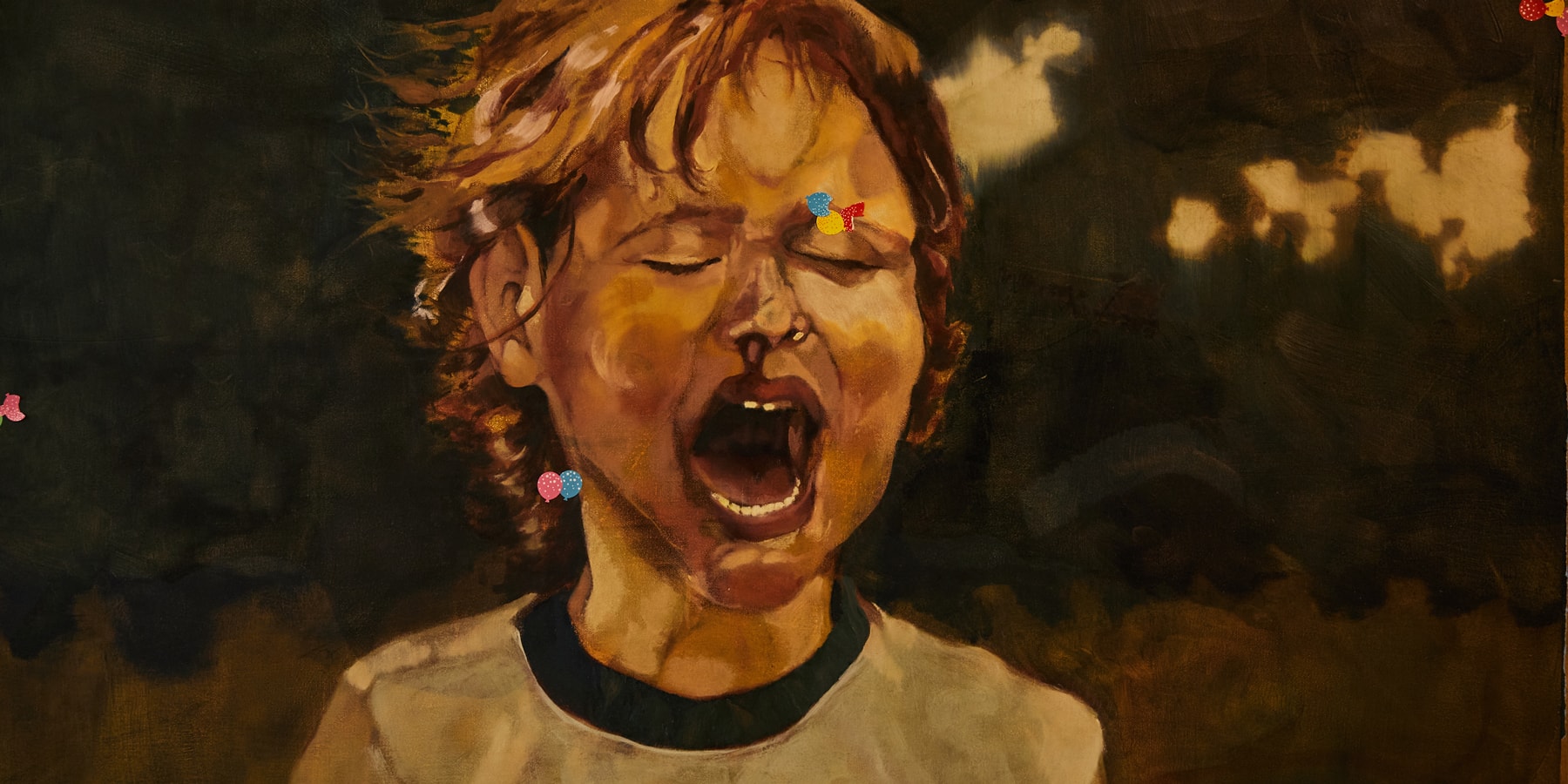
What projects are you currently working on?
I recently had a solo exhibition open with Gallery Anthony in Chicago; “Thorns In The Manger” I’m also currently working towards a group exhibition in the fall with curator AJ Girard – not only a fellow Dallas graduate – known for putting together ‘Shattered Glass’. Absolute legend.
Learn more about Henry Swanson’s practice, processes and artworks here.
Photography by Michael Kusumadjaja for HypeArt


